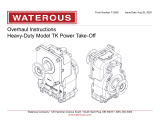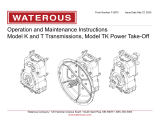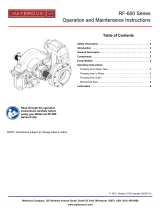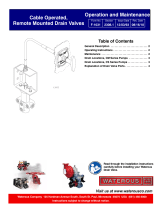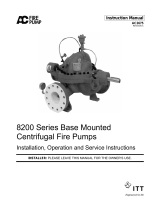Page is loading ...

Read through the safety information
and overhaul instructions carefully
before repairing your Waterous CG
Series Fire Pump.
Table of Contents
Safety Information 2.............................................
Introduction 3..................................................
General Description 3...........................................
General Overhaul Information 3..................................
Tools and Equipment 3..........................................
Preliminary Testing 3............................................
Cleaning 3......................................................
Pump Bodies and Impellers 3......................................
Bearings, Gaskets, Seals and O-rings 4.............................
Impeller Shafts 4.................................................
Installing Ball Bearings 4..........................................
Installing Body Gaskets 4.........................................
Disassembly 4..................................................
Inspection and Repair 5.........................................
Mechanical Seal 5...............................................
Impellers 5......................................................
Installing Undersize Wear Rings 6..................................
Reassembly 6..................................................
Mechanical Seal 6...............................................
Packing 7.......................................................
Packing Removal 7...............................................
Packing Installation 8.............................................
Packing Adjustment 8............................................
Final Assembly 9.................................................
Testing 10......................................................
Hydrostatic Testing 10............................................
Operational Testing 10............................................
NOTE: Instructions subject to change without notice
Waterous Company, 125 Hardman Avenue South, South St. Paul, Minnesota 55075 USA (651) 450-5000
www.waterousco.com
F-1031, Section 4202 (Revised: 07/12)
CG Series Centrifugal Fire Pumps
Overhaul Instructions

Page 2 of 10F-1031, Section 4202
Safety Information
Please read through the safety information and operating instructions carefully before using your Waterous Fire Pump.
WARNING
Death or serious personal injury might occur if proper operating procedures
are not followed. The pump operator, as well as individuals connecting supply
or discharge hoses to the apparatus must be familiar with these pump operat
ing instructions as well as other operating instructions and manuals for the ap
paratus, water hydraulics and component limitation.
WARNING
Pressure Hazard. May result in personal injury.
Prior to connection or removal of hoses, caps or other closures with pump in
take or pump discharge connections, relieve pressure by opening drains or
bleeder valves. Bleeder valves should also be used while filling a hose con
nected to an intake with water.
WARNING
Scalding Water Hazard. May result in serious burns.
When operating the pump, be sure to open at least one discharge valve slight
ly to prevent the pump from overheating. If the pump runs for a few minutes
completely closed, it may heat the water enough to scald someone when the
valve is opened. Overheating can damage the packing, seals and other pump
parts. If the apparatus builder has installed a by-pass system or other provi
sion designed to prevent overheating, opening a discharge valve may be un
necessary.
WARNING
Unexpected Truck Movement. May result in serious personal injury or
death.
Failure to properly shift transmission in accordance to the transmission oper
ating instructions may result in unexpected truck movement which may result
in serious personal injury or death.
WARNING
Rotating Parts Hazard or Unexpected Truck Movement. May result in seri
ous personal injury or death.
Stop the engine, set parking brake and chock the wheels before going under
the truck to adjust packing or to check packing gland temperature.
WARNING
Packing Gland and Pump Body Temperature Hazard. May result in seri
ous burns.
Heat is dissipated through the cross-section of the packing, transferring the
heat to the packing gland and pump body.

F-1031, Section 4202 Page 3 of 10
Introduction
This section contains overhaul instructions for Waterous CG Series centrif
ugal fire pumps. Since several types of transmissions are used with the
CG Series pumps, the transmissions are covered in separate sections be
ginning with number 4300.
NOTE that this instruction is written to cover several variations of the CG
Series pumps, not all steps will apply to any one pump.
Also refer to the Service Parts List (SPL documents) furnished with your
pump to aid in further part identification and repair parts ordering.
General Description
The CG series pumps are single stage centrifugal pumps. Depending on
the type of transmission used, the pump may be used as a front-mounted
pump (driven from the engine crankshaft), power take-off driven, direct-en
gine driven (bellhousing mounted) or midship mounted. They are available
in capacities up to 750 gpm (2850 l/m). The CGVG is a midship or PTO
mounted pump with a curved intake cross pipe. CGN (not available after
4/21/06) pumps are front-mounted, direct-engine mounted or PTO-driven
with a 5 inch flanged intake fitting. CGV pumps are front, direct-engine
mounted to PTO driven with a Victaulicr intake fitting. CGR (not available
after 4/21/06) pumps are front-mounted, direct-engine mounted or PTO-
driven with a threaded intake fitting.
General Overhaul Information
Tools and Equipment
The following tools and equipment are needed to overhaul a pump:
1. Usual automotive mechanic's hand tools.
2. An arbor press for assembling or disassembling components.
3. An engine lathe for turning impeller hubs.
4. A suitable hoist and slings.
5. Torque capability up to 325 lb-ft.
While no special tools and equipment are required, a few special items are
illustrated or described so the mechanic can make them or they are avail
able from the apparatus manufacturer or the Waterous Company. These
special items are not absolutely necessary, but they will make the me
chanic's work much easier.
Preliminary Testing
Before disassembling a pump, test it thoroughly, if possible, and record
the results. A comparison of this test with periodic tests recommended in
form F-1031, Section 1000 can often reveal specific pump troubles. Ex
cessive speed, for instance, indicates that impellers and/or wear rings are
probably worn.
Cleaning
The continued satisfactory operation of a pump depends to a great extent
upon the cleanliness of its internal parts. Sand, dirt or other abrasive mate
rial will wear bearings, gears and related parts. Before disassembling a
pump for repairs, be sure to clean its exterior. Make sure the working
space, benches and tools are clean. Use only clean, lint-free cloths to
wipe off components. Before reassembling a pump or its components, be
sure to clean them thoroughly.
Pump Bodies and Impellers
Flush out these components and related parts with clean water. Use a stiff
brush to remove loose scale, caked sediment, etc. Be sure to remove all
traces of old gaskets. Examine pump bodies, covers, adapters and fittings
for cracks, severe corrosion or other damage. Almost all damage to these
parts results from improper use or maintenance, or from freezing. Replace
defective parts.

F-1031, Section 4202 Page 4 of 10
Bearings, Gaskets, Seals and O-rings
Parts of this nature are frequently damaged during removal or disassemb
ly. In addition, they sometimes deteriorate or lose their effectiveness be
cause of age or misuse. Replacing these parts whenever overhauling a
pump is a good policy.
Impeller Shafts
Examine shaft for severe scratches, grooves or corrosion - especially un
der packing or mechanical seals. If scratches are not severe, and are not
under packing and seals, clean them with a fine-cut file. Grooves under
the packing are usually permissible if they are not sharp or too deep. Even
slight longitudinal scratches will cause leaks and should be removed.
Installing Ball Bearings
Most Waterous pumps are designed so that ball bearings fit tightly on their
shafts and have relatively loose fits in the bearing housings. When mount
ing these bearings on shafts, always apply force to the inner races. When
bearings have a tight fit in the housings, and a heavy force is necessary to
install them, be sure to apply force only to the outer bearing races. For
either type of fit, applying force to the wrong bearing race may damage the
balls and race.
Installing Body Gaskets
To provide added sealing for gaskets between body halves, or between
bodies and intake adapters, coat both sides of these gaskets with a suit
able sealant. A compound such as Permatex Super 300 is recommended
for this application. Be sure all traces of previous gaskets and sealant are
removed before installing new gaskets.
Disassembly
A CG Series pump may be disassembled in several ways, depending on
the following:
•Type of transmission
•Piping arrangement
Removing the pump and transmission together, and then disassembling
the pump is usually the easiest method. Refer to service parts list (SPL)
furnished with your pump for component identification.

F-1031, Section 4202 Page 5 of 10
" To disassemble the pump, perform the following:
1. Disconnect the drain lines and similar connections to the pump and pump
transmission.
2. Drain the lubricant from the pump transmission by removing the oil drain
plug.
3. Disconnect the drive shafts from the pump transmission.
4. Disconnect the intake and discharge piping from the pump.
NOTE: Unless the body and/or the front wear ring is damaged, it
may be easier to leave the piping connected and go to Step 6.
5. Remove the pump and transmission.
6. Remove the cap screws and copper washers, attaching the intake adapt
er to the body.
7. Remove Intake and discard gasket.
8. Remove the impeller shaft cotter pin and nut.
9. Remove the impeller and square key.
NOTE: The impeller has three tapped holes in the eye to allow a
puller to be used to remove it.
10a. Pumps with Mechanical Seals: If the pump has a mechanical seal, re
move bolts, washers and nuts attaching pump head to the transmission.
Lubricate impeller shaft. The mechanical seal and pump head may now
be removed as a unit. NOTE that the rear wear ring will come off with
the head.
NOTE: Care must be taken not to damage the impeller shaft.
10b. Pumps with Packing: If the pump has packing, loosen unbalanced
nuts and remove the packing gland. Packing gland is split into two
halves for removal. The studs, unbalanced nuts and washers will re
main attached to the pump head.
Remove the caps screws, bolt and nut attaching the pump head to the
transmission.
Remove the pump head. NOTE that the rear wear ring will come off
with the head.
11. Remove flinger ring.
NOTE: Removing the impeller shaft from the pump transmission
is not necessary unless it is damaged. If the impeller shaft re
moval is necessary, see the pump transmission overhaul instruc
tions.
NOTE: Removing wear rings from the body or head is necessary
only if they are damaged or badly worn. (See impellers section of
inspection and repair).
Inspection and Repair
The following points cover inspection and repair of the major components
of CG Series pumps. Check all parts that are not covered in this instruc
tion in accordance with standard automotive shop practices. If the slightest
doubt exists about the actual condition of any part, replace the part as a
precautionary measure.
Mechanical Seal
If a pump has a mechanical seal, installing a new seal during reassembly is required.
Impellers
Check wear rings and impeller hubs for deep grooves or scratches. Care
fully measure the outside diameter of the impeller hubs and the inside di
ameter of the wear rings installed in the body and head. If the difference
between these two measurements exceeds 0.020 in., replace the wear
rings as directed below.
NOTE: Wear rings may be removed by crisscrossing two pry bars
under opposite sides of the wear ring. Pry up the wear ring by apply
ing equal pressure to both pry bars. The wear rings also have two
tapped holes in them to allow a puller to be used to remove them.

F-1031, Section 4202 Page 6 of 10
Installing Undersize Wear Rings
Replacement rings are available as follows:
•0.025 in. undersize
•0.050 in. undersize
•0.075 in. undersize
If inspection shows that the wear ring clearances are excessive or the im
peller hubs are scored or grooved, turn the impeller hub on a lathe to an
acceptable dimension.
Table 1 shows the original hub dimensions for each impeller and the re
work dimensions for each degree of undersize.
Flame plated impeller hub wear ring clearance is usually restored by
installing a replacement wear ring with the same dimensions as the origi
nal wear ring since most wear occurs on the wear ring, not the impeller
hub. Flame plated impellers are the numbers with the “T” suffix.
Table 1. Impeller and Wear Ring Repair Dimensions
Impeller Number Original HUB Diameter Original Wear Ring Number Reworked HUB Diameter New Wear Ring Number
7309-F
70690 4.623 / 4.621 61269
4.598 / 4.596
4.573 / 4.571
4.548 / 4.546
61269-25
61269-50
61269-75
70423
70689 5.5015 / 5.4995 61029
5.476 / 5.474
5.451 / 5.449
5.426 / 5.424
61029-25
61029-50
61029-75
71887
71899 5.500 / 5.498 62363
62364
5.492 / 5.494
5.467 / 5.469
5.442 / 5.444
62363-25
62363-50
62363-75
62364-25
62364-50
62364-75
Keep the hub diameters within 0.015 in. TIR of the impeller shaft bore. If
the impeller hubs do not clean up at first undersize dimension, turn the
hub down to the next degree of undersize. Replace the impeller if the hubs
do not clean up at the last undersize dimension.
Before pressing new wear rings in place, remove all corrosion from body
and head counterbores and apply a generous amount of lubriplate or simi
lar lubricant to the outer ring surfaces. With a suitable arbor, carefully
press the rings into the body and head counterbores. Make sure the rings
are seated firmly against the counterbore shoulders.
Reassembly
Reassembly of the CG and CGVG pumps is essentially the same as the
disassembly procedure, except it is reversed. Note that if undersize wear
rings are required, they should be installed during reassembly. Also, if a
new impeller is needed, install new standard size wear rings for the impel
ler.
Mechanical Seal
CAUTION
The mechanical seal primary and stationary rings are made of brittle ma
terial. The material can be cracked or chipped. Extra care must be taken
when handling these rings.
NOTE: If Waterous Mechanical Seal Lubricant part no. 52608 is
not available, P80 rubber lubricant, straight dish soap or glycerin
may be substituted.
1. Install mechanical seal after volute body has been reattached to trans
mission.

F-1031, Section 4202 Page 7 of 10
NOTE: To protect the rubber bellows of the mechanical seal,
place a piece of masking tape over the keyway on the impeller
shaft, making sure that the tape is able to be removed after bel
lows has passed over the keyway.
2. Apply a light coating of seal lubricant to the O-ring on the stationary
ring assembly. Slip the ring over the end of the impeller shaft, with the
finish lapped face of the ring facing up (the opposite side of a new seal
ring has a mark on it). Slide it along the shaft and push it into and seat
it in the bore in the mechanical seal housing. If it can not be pushed in
by hand it may be tapped into place by use of a block of wood be
tween the ring and a hammer. (Protect sealing surface).
3. Wipe the face of the previously installed stationary ring of the mechan
ical seal with a clean cloth and denatured alcohol.
4. Apply a light coating of seal lubricant to the inside of the bellows as
sembly and wipe the face of the carbon ring with a soft cloth and de
natured alcohol. Liberally coat impeller shaft with seal lubricant. Slide
the bellows assembly onto the shaft until the carbon ring contacts the
stationary seal ring. Install spring on bellows assembly.
5. Slide impeller on the shaft. The mechanical seal is held in place by
notches in the impeller. (Retaining ring used prior to 4/11/91).
IL102
4
Figure 1. Mechanical Seal Lubrication Application
Stationary Ring
Lubricate O-Ring
Coat Shaft Area Bellows
Assembly Must Slide Over
Seat with Stationary Ring.
Bellows Assembly
Coat Inside of
Bellows Assembly
If Lubricant should get on faces of Stationary and
Primary Ring (Surfaces which seat
Against Stationary Ring), Wipe it Clean with a Soft Cloth
and Denatured Alcohol
Packing (No Longer Available After 2/4/05)
Waterous uses a braided graphite fiber, with reinforced flexible graphite
yarns and high purity graphite filament yarns that appear on the corners as
well as throughout the body of the packing. The graphite reinforcement
allows the flexible graphite yarns to provide greater tensile strength.
This type of packing reduces the frictional heat created between the shaft
and the I.D. of the packing. By dissipating the heat through the cross sec
tion of the packing, the heat is transferred to the packing gland and the
pump body.
WARNING
!
Packing Gland and Pump Body Temperature Hazard. May result in
serious burns.
Heat is dissipated through the cross-section of the packing, transfer
ring the heat to the packing gland and pump body.
Packing Removal
WARNING
!
Truck movement hazard.
May cause serious personal injury.
Stop engine, set the parking brake and chock the wheels before going
under truck to remove packing.
1. Remove the unbalanced nuts, flat washers and packing gland halves.
2. Engage the pump per appropriate operating instructions. Operate the
pump, gradually increasing the discharge pressure until the packing is
forced out of the stuffing box. Pressure in excess of 300 psi (20.7 bar)
may be required.

F-1031, Section 4202 Page 8 of 10
CAUTION
Pump overheating hazard.
May cause damage to the pump.
Circulate enough water through the pump to prevent overheating. Do
not pressurize the pump over the rated maximum discharge pressure
of the pump.
3. If all packing is not forced out, it may be necessary to remove the re
maining packing by hand, using a pick or similar device. Waterous has
a packing removal tool (P/N 5782) available for this purpose, see Fig
ure 2.
4. Replace packing per instructions on the next page.
Figure 2. Packing Removal Tool
Packing Installation
1. Before installing the new packing, be sure that all of the old packing is
removed from the stuffing box.
2. Be sure that the stuffing box and the shaft are clean and free of any
packing residue.
3. Lightly lubricate that packing ring I.D. and O.D. with mineral oil, auto
motive grease or engine oil for installation purposes.
4. Make sure the packing is clean.
5. Carefully install one ring of packing. With the aid of packing glands,
push the packing into the stuffing box as far as possible. Repeat this
operation with each ring, staggering the joints at least 90_ apart.
Install the packing rings until the top of the last ring is about 1/4 inch
from the end of the stuffing box (at least 1/8 inch is required for the
packing gland nose entrance into the stuffing box), see Figure 3.
NOTE: Be sure that the packing joints are staggered at least 90_
apart.
6. Install packing glands, nuts and washers. Tighten gland nuts one flat
beyond finger tight, see Figure 3.
NOTE: The milled slot on the nut should face the gland.
7. Adjust packing as required per instructions on the next page.
Figure 3. Packing and Gland Installation
Packing Adjustment
The pump packing is designed and adjusted to drip slightly during opera
tion. This is to cool and lubricate the packing. It is desirable to adjust the
stuffing box to maintain a leakage rate of 10 to 120 drops per minute when
operating at a discharge pressure of 150 psi.
Leakage through the braided flexible graphite (BFG) packing may be at
zero or diminish to zero leakage and may not respond to loosening of the
packing nuts to restore leakage. (See Adjustment Step 3.) While the pack
ing gland and stuffing box and pump body may reach high temperatures
during this time, the impeller shaft will be protected from heat damage.

F-1031, Section 4202 Page 9 of 10
CAUTION
Pump overheating hazard.
May cause damage to the pump.
Circulate enough water through the pump to prevent overheating.
WARNING
!
Truck movement hazard.
May cause serious personal injury.
Stop engine, set the parking brake and chock the wheels before going
under truck to adjust packing.
1. Engage pump per appropriate operating instructions. Operate the
pump at the capacity pressure shown on the serial plate for ten (10)
minutes.
CAUTION
Observe the stuffing box drip rate from the side of the truck.
2. Observe leakage. Normal leakage is 10-120 drops per minute.
3. If drip rate is considered high, stop the engine and tighten the packing
gland nuts 1/2 to 1 flat (maximum of 1/6 of a revolution). Make ap
propriate adjustments starting with 1 flat, when approaching the final
adjustment reduce to 1/2 flat. This reduces the possibility of over tight
ening. Tighten the gland nuts equally to ensure that the packing
gland goes on straight. Gradually reducing leakage during the first
hour of operation will result in a better seal over a longer period of
time.
CAUTION
Stopping the leakage entirely at this point will cause the packing
to overheat.
4. Operate the pump at the capacity pressure shown on the serial plate
for two (2) minutes to let packing run in, then observe the drip rate.
WARNING
!
Packing Gland and Pump Body Temperature Hazard. May result in
serious burns.
Heat is dissipated through the cross-section of the packing, transfer
ring the heat to the packing gland and pump body.
5. Repeat steps 3 and 4 until the drop rate is acceptable.
NOTE: After adjusting the packing, the pump must pass the va
cuum test described on the next page.
Final Assembly
To complete final assembly, perform the following:
1. Connect the propeller or drive shaft to the pump transmission.
2. Connect the intake and discharge piping.
3. Connect the cooling and drain lines, electrical wiring and similar equip
ment to the pump and accessories.
4. Fill the pump transmission with lubricant as directed in the transmission
operation and maintenance instructions.

F-1031, Section 4202 Page 10 of 10
Testing
Before a pump can be returned to service, it is advisable to give the pump a hydrostatic and operational tests to check it for leaks and to make sure the
pump operates properly.
Hydrostatic Testing
1. Connect the pump to a hydrant or other pressurized water supply.
2. Close all drain lines and open the discharge and priming valves.
3. Open hydrant until the water runs out through the discharge valves and
discharge pipe in priming pump (if used).
4. Close all valves. Be sure to evacuate all air from the pump.
5. Check for leaks with a portable light. If leaks are discovered, tighten con
nections or attaching parts as necessary. Repeat until all leaks are elimi
nated.
NOTE: If a mechanical seal is used, the seal may leak under hy
drostatic pressure; however, it should stop leaking after the seal
faces are run in during operational testing.
6. Shut hydrant valve after all leaks are eliminated.
7. Drain pump completely and disconnect intake hose.
Operational Testing
1. Adjust packing as described in packing section.
WARNING
!
Do not adjust gland nuts while pump is running. Observe stuffing box
leakage by watching drippage from the side of the truck.
2. Operate the pump at its maximum intended service pressure. Do not ex
ceed 350 psi (450 psi with positive pressure).
3. Check for leaks with a portable light. If leaks are discovered, stop the
pump and tighten connections or tighten attaching parts as necessary.
Repeat until all leaks are eliminated.
4. Check for unusual noises, oil leaks, overheated bearings, etc. while the
pump is running. If anything unusual is discovered, stop the pump im
mediately and determine the cause of the problem.
NOTE: After reassembling pump, perform vacuum test per NFPA
1911, before the truck is placed back in service.
Vacuum Test
1. Remove all caps except openings without valves. Close all discharge,
intake and drain valves and other similar openings. Operate priming
device to create a vacuum of about 22 in. Hg/.735 atmosphere in
pump, then stop primer and engine.
2. Watch the pressure gauge; if vacuum drops more than 10 in. Hg/.334
atmospheres in five (5) minutes, listen for air leaks around the packing
gland, gaskets, valves, etc.
3. Replace gaskets, re-adjust packing, repack or otherwise repair source
of trouble.
4. Repeat test.
/
